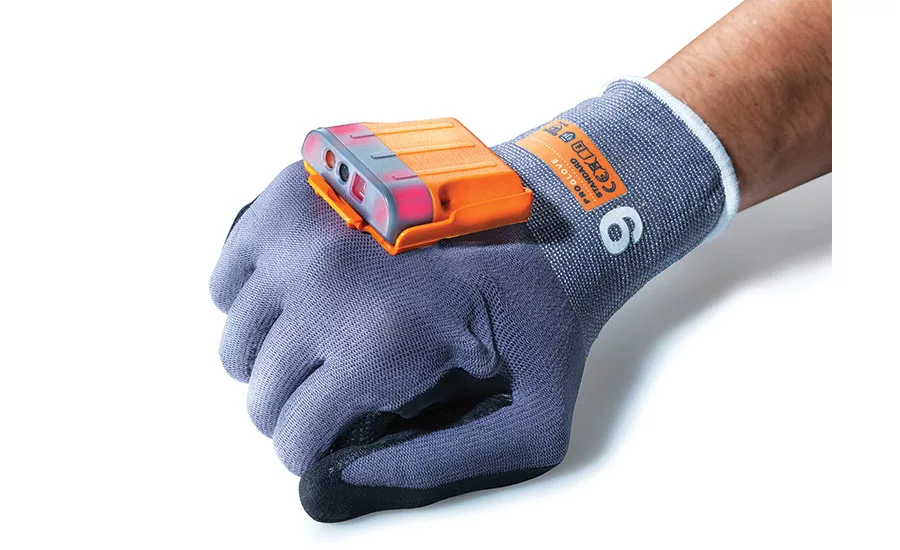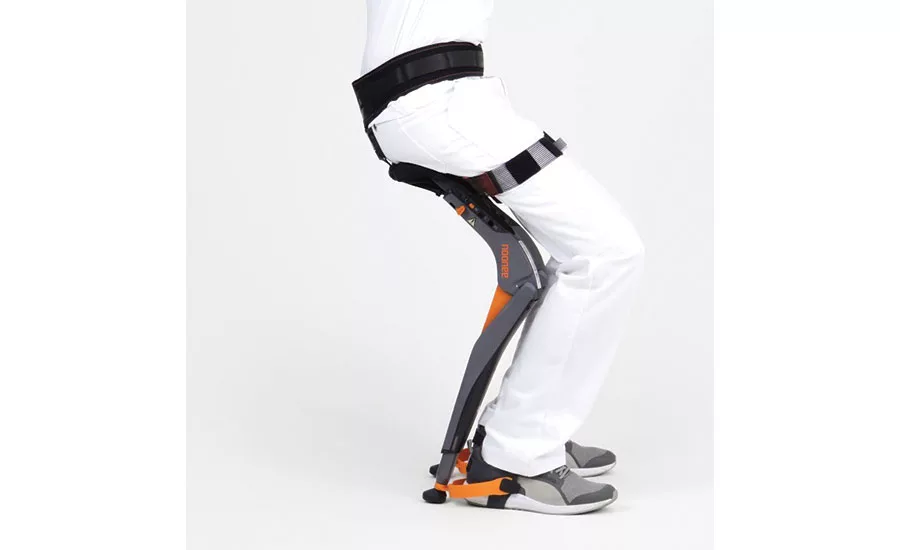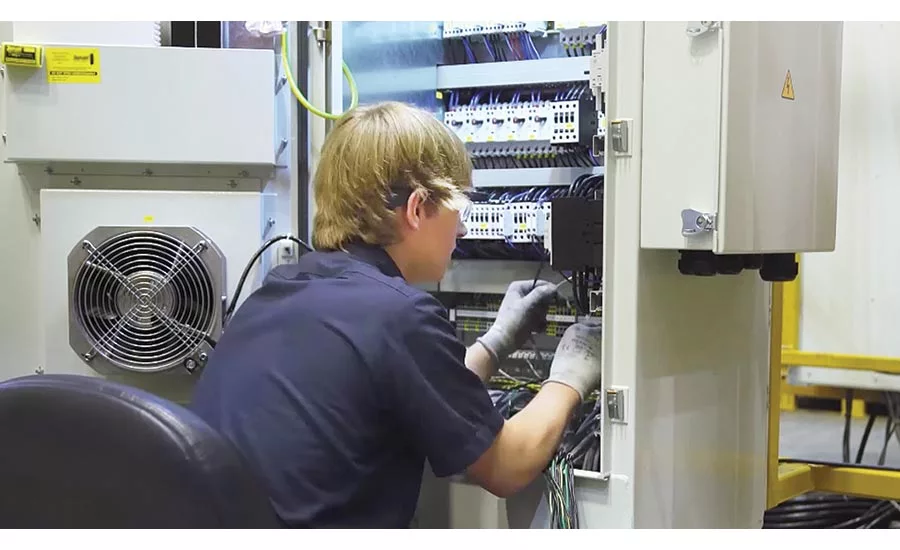Innovation
Wearable technology offers food processors information, efficiency
The future food factory could soon be filled with everything from smartwatches to smart gloves and augmented reality

The Mark glove from ProGlove allows manufacturing and logistics staff to work faster, safer and more easily, and allows process steps to be documented hands free via a 2D barcode engine.
Photo courtesy of ProGlove

The Chairless chair from noonee is a flexible, wearable ergonomic sitting support designed for manufacturing companies where workers are required to stand for a long period of time and traditional sitting methods are not realistic.
Photo courtesy of noonee

The word “wearables” might be most equated with a consumer device like a Fitbit, but many companies are working to expand the sector and put their innovations on the manufacturing plant floor, including smartwatches, smart gloves and smart glasses.
ABI Research, the market advisory firm providing strategic guidance on transformative technologies, forecasts wearable data and analytics services revenue will reach more than $838 million in 2022. That’s an increase from more than $247 million in 2017, a CAGR of over 27 percent—and much of that will be in the manufacturing sector.
“Wearable devices are going to become much more prevalent within factories in the coming years,” says Stephanie Lawrence, research analyst at ABI. “In particular, smart glasses [which overlay instructions and provide a communications interface], smartwatches [which display haptic alerts], wearable scanners [which enable users to scan items and process barcodes/QR codes] and hearables [which enable users to communicate with others] will begin to see a much greater popularity on the factory floor.”
The devices can provide users with important updates and alerts, she says. And the alerts are more likely to be noticed on a smartwatch than on a smartphone, particularly in a loud, busy factory.
“For example, if a smartphone in a pocket gets a haptic and audible notification, it can easily be missed, but a vibrating device on the user’s wrist is much more noticeable,” Lawrence explains. “Notifications to smartphones also require the user to take out the device from their pocket, causing them to stop what they are doing. A notification to a smartwatch enables the user to glance at their wrist, reducing the amount of downtime.”
The Industrial Internet of Things (IoT) is helping to pave the path for all these innovations, as everything on the plant floor becomes more connected and able to collect a lot of data.
“In the wider IoT market view, wearables provide a human-centric data source—a valuable asset for efficiency and safety improvements in the workforce,” Lawrence says.
But data is as only as good as its analytics component. She warns that raw data collected from wearable devices can provide too much information that doesn’t have any real meaning.
“With access to data analytics, this information becomes much more meaningful, allowing the user … or company to take action,” Lawrence says.
Helping to get the job done
One type of wearable that has had trouble gaining traction with consumers is Google Glass, created under Google X. However, since its introduction in 2013, Google Glass is now tailoring its offerings to those working in manufacturing and other hands-free environments.
Google X says its new Glass Enterprise Edition “intuitively fits into your workflow and helps you remain engaged and focused on high value work by removing distractions. A quick ‘OK Glass’ can activate the right application for you at any time.”
It also allows users to access training videos, images annotated with instructions or quality assurance checklists.
“Glass also can connect you with coworkers in an instant, bringing expertise to right where you are,” Google says, adding that users can “invite others to ‘see what you see’ through a live video stream so you can collaborate and troubleshoot in real time.”
“Devices such as smart glasses show workflow instructions, such as how to build or fix a product or piece of machinery, in the user’s line of sight,” Lawrence says. “This prevents them from needing to access separate computer or paper manuals, which involve the user looking away from their work. With smart glasses, the user can access the information whilst completing the task.”
The glasses also can provide users with a communications interface that allows them to discuss any issues with an expert who may even be off-site.
“In some instances, this expert can also see what the user is seeing and draw on their display, such as circling the correct component,” Lawrence says.
But for companies wary of going full Google Glass, there are other options.
“Devices such as wearable scanners [and smart gloves] enable users to scan the barcodes of components or workflow process barcodes/QR codes whilst building or fixing a product or machine,” Lawrence explains. “This ensures that the workflow process is recorded and that the worker is following the correct steps. If the wrong barcode is scanned, an alert can be sent to ensure that the worker doesn’t complete the incorrect step, reducing the number of errors.”
Again, it comes down to being a lot more convenient than a smartphone or an iPad.
“With a handheld device, the user has to stop what they are working on, pick up the scanner, scan the barcode, put down the scanner and then get back to the task. With a wearable scanner, the user can scan the barcode as they select the component,” Lawrence says.
Kinemic provides gesture interaction solutions using only wearables or smartwatches. Tom Lenz, founder and managing director, says its devices help customers with software development and integration, so that they can realize the maximum benefit from its hands-free interaction solution.
“The main benefit that we have found is the ability to be completely hands free, eliminating contamination problems and alleviating the need for constant cleaning and disinfection,” he explains. “This becomes possible, because the wearable can be worn under gloves.”
Of course, the next logical step is a smart glove, which is where companies like ProGlove come in.
The industrial startup from Munich recently launched a smart glove, called “Mark.” The device is a plug-and-play solution for production and logistics, where companies get the impact of efficiency and ergonomic improvements immediately.
The company worked with clients, such as Audi, BMW, Skoda, MAHLE and John Deere, to develop it for manufacturing. ProGlove founder and CEO, Thomas Kirchner claims it can save 2,000 minutes a day in one warehouse—immediately without integrational effort.
It enables manufacturing and logistics staff to work faster, safer and more easily, and allows process steps to be documented hands free via a 2D barcode engine. And that means tracking and tracing parcel or manufacturing parts comes down to a simple glove scan.
The worker gets direct feedback to his or her working steps via optical, acoustic and even haptic feedback—which ensures a new level of process quality and efficiency. Integrated gesture sensors open the possibility for gesture control.
The core of the design of the “Mark” smart glove is an implemented computer unit and a working glove that can be easily replaced when it wears out.
The company recently announced that Lufthansa Technik Logistik Services (LTLS) will be using ProGlove products.
“ProGlove’s smart data glove has been very well received by our employees and makes their work easier. It is like it was made for us,” explains Dr. Harald Kolbe, head of digital innovation at LTLS. “As part of our digitization program, we are looking to work with startups to test new technologies that have reached, or are about to reach, market maturity.”
But not all wearables must be connected to the internet, such as the Chairless chair, a flexible, wearable ergonomic sitting support from noonee. Designed for manufacturing companies where workers are required to stand for a long period of time and traditional sitting methods are not realistic, the device allows users to walk with the sitting support while wearing it, without obstructing the work space and, at the same time, avoiding strenuous postures, such as bending, squatting or crouching.
During the development process, noonee worked closely with employees from Audi, Seat, Skoda, Daimler, BMW and Renault, amongst others, to tailor the Chairless chair to the needs of the end users and the dynamic environment of production lines.
Safely incorporating wearables
Integrating wearable technology isn’t without its potential hazards, something the US Military recently learned the hard way. According to an article in Newsweek, after Strava Labs, a fitness-tracking app, released a heat map of its users, it also accidently revealed the location, layout and staffing of secret US military bases.
The map, first published by Strava Labs in November 2017, covered 17 billion miles and a total recorded activity duration of 200,000 years.
“Our global heat map is the largest, richest and most beautiful dataset of its kind,” Drew Robb, a data engineer at Strava, said in a blog post at the time. “It is a direct visualization of Strava’s global network of athletes.”
However, a military analyst posted a series of tweets detailing how Strava’s heat map had revealed sensitive information. Experts say the app could cause a problem if soldiers use it like everyone else does—to track where and when they exercise.
The issue brings up important questions about devices in use in many different applications. Could certain apps or wearables lead to security issues for a plant? And if so, how should a company go about incorporating these technologies safely onto the factory floor?
“Small-scale trials and pilots should always be undertaken before a full-scale rollout,” Lawrence says. “This helps the company to ensure that the devices work as required and improve productivity, and gives employees the opportunity to provide feedback on whether or not the devices are of use. Within these trials, the company can determine whether or not the information that the users have access to is appropriate and not overwhelming.”
And there’s a lot of things for companies to consider when they run these trials, the most important of which is how easy it is to integrate the technology with the current infrastructure.
“Supporting software, platforms and enterprise mobility management solutions should be looked into, as well, to help ensure that the devices connect as required and to provide the necessary levels of security,” Lawrence says. “These solutions enable companies to set password and encryption rules, and also enable IT teams to remotely control the devices, allowing them to lock/wipe a lost or stolen device. IT teams can also remotely update the devices and install new applications as required, ensuring that each worker has access to everything that they require in the future. These solutions should be scalable, enabling the company to add more devices in the future whilst still having the protection.”
Companies should also communicate with employees throughout the process, ensuring that any concerns are dealt with immediately.
“For example, employees are often worried about how the devices may track them and how this data may be used against them,” Lawrence says. “Companies must discuss with employees that the devices are being used to improve worker processes and that an individual’s data, such as how much work has been completed, will not be used. Training sessions should also be provided to ensure that each worker knows exactly how to use the devices, preventing any issues further down the line.”
For more information:
ABI Research, www.abiresearch.com
Kinemic, kinemic.com
ProGlove, www.proglove.de
noonee, www.noonee.com
Looking for a reprint of this article?
From high-res PDFs to custom plaques, order your copy today!









